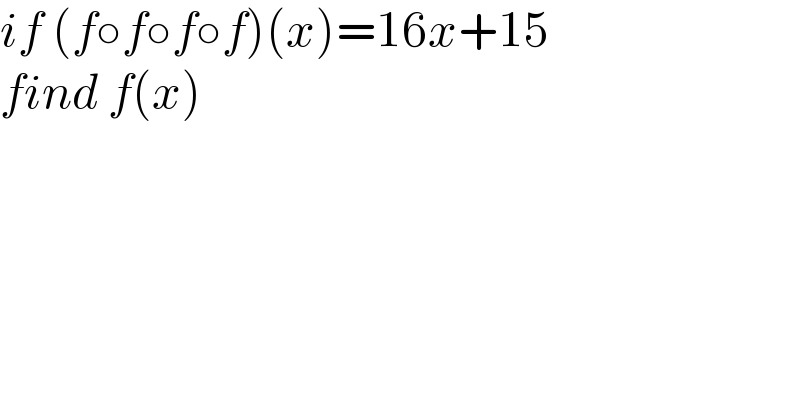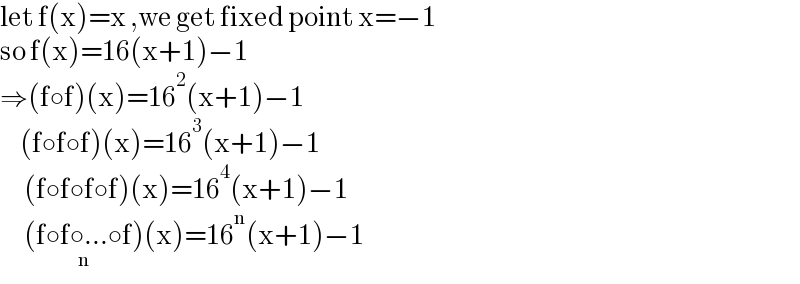
Question Number 151080 by malwan last updated on 18/Aug/21

$${if}\:\left({f}\circ{f}\circ{f}\circ{f}\right)\left({x}\right)=\mathrm{16}{x}+\mathrm{15} \\ $$$${find}\:{f}\left({x}\right) \\ $$
Answered by Mokmokhi last updated on 18/Aug/21

$$\mathrm{It}\:\mathrm{is}\:\mathrm{reasonable}\:\mathrm{to}\:\mathrm{say}\:{f}\left({x}\right)\:\mathrm{is}\:\mathrm{linear}\:\mathrm{by}\:\mathrm{rejecting}\:\mathrm{other}\:\mathrm{possibilities}. \\ $$$$\mathrm{Then}\:{f}\left({x}\right)={ax}+{b}\:\mathrm{for}\:\mathrm{some}\:\mathrm{unknowns}\:{a}\:\mathrm{and}\:{b}. \\ $$$$\mathrm{The}\:\mathrm{value}\:\mathrm{of}\:{a}\:\mathrm{should}\:\mathrm{be}\:\mathrm{2}\:\mathrm{or}\:−\mathrm{2}. \\ $$$$\mathrm{If}\:{a}=\mathrm{2}.\:{b}=\mathrm{1}. \\ $$$$\mathrm{If}\:{a}=−\mathrm{2}.\:{b}=\mathrm{20}. \\ $$
Commented by malwan last updated on 18/Aug/21

$${thank}\:{you}\:{sir} \\ $$
Answered by qaz last updated on 18/Aug/21

$$\mathrm{let}\:\mathrm{f}\left(\mathrm{x}\right)=\mathrm{x}\:,\mathrm{we}\:\mathrm{get}\:\mathrm{fixed}\:\mathrm{point}\:\mathrm{x}=−\mathrm{1} \\ $$$$\mathrm{so}\:\mathrm{f}\left(\mathrm{x}\right)=\mathrm{16}\left(\mathrm{x}+\mathrm{1}\right)−\mathrm{1} \\ $$$$\Rightarrow\left(\mathrm{f}\circ\mathrm{f}\right)\left(\mathrm{x}\right)=\mathrm{16}^{\mathrm{2}} \left(\mathrm{x}+\mathrm{1}\right)−\mathrm{1} \\ $$$$\:\:\:\:\:\left(\mathrm{f}\circ\mathrm{f}\circ\mathrm{f}\right)\left(\mathrm{x}\right)=\mathrm{16}^{\mathrm{3}} \left(\mathrm{x}+\mathrm{1}\right)−\mathrm{1} \\ $$$$\:\:\:\:\:\:\left(\mathrm{f}\circ\mathrm{f}\circ\mathrm{f}\circ\mathrm{f}\right)\left(\mathrm{x}\right)=\mathrm{16}^{\mathrm{4}} \left(\mathrm{x}+\mathrm{1}\right)−\mathrm{1} \\ $$$$\:\:\:\:\:\:\left(\underset{\mathrm{n}} {\mathrm{f}\circ\mathrm{f}\circ...\circ\mathrm{f}}\right)\left(\mathrm{x}\right)=\mathrm{16}^{\mathrm{n}} \left(\mathrm{x}+\mathrm{1}\right)−\mathrm{1} \\ $$
Commented by malwan last updated on 18/Aug/21

$${thank}\:{you}\:{sir} \\ $$
Commented by qaz last updated on 19/Aug/21

$$\mathrm{sorry}.\mathrm{there}\:\mathrm{is}\:\mathrm{a}\:\mathrm{error}. \\ $$$$\mathrm{we}\:\mathrm{need}\:\mathrm{make}\:\mathrm{a}\:\mathrm{reverse}\:\mathrm{iteration}. \\ $$$$\left(\mathrm{f}\circ\mathrm{f}\circ\mathrm{f}\circ\mathrm{f}\right)\left(\mathrm{x}\right)=\mathrm{2}^{\mathrm{4}} \left(\mathrm{x}+\mathrm{1}\right)−\mathrm{1} \\ $$$$.... \\ $$$$\mathrm{f}\left(\mathrm{x}\right)=\mathrm{2}\left(\mathrm{x}+\mathrm{1}\right)−\mathrm{1}=\mathrm{2x}+\mathrm{1} \\ $$
